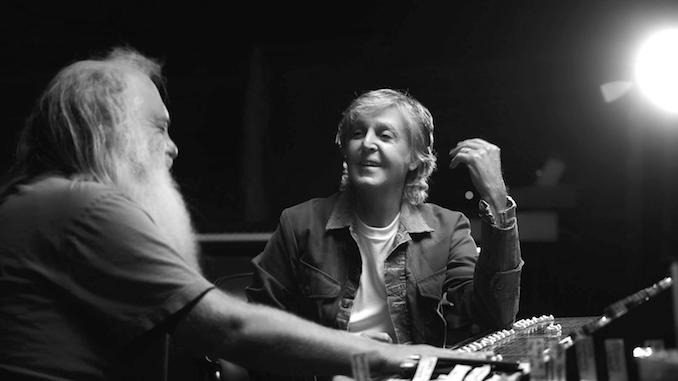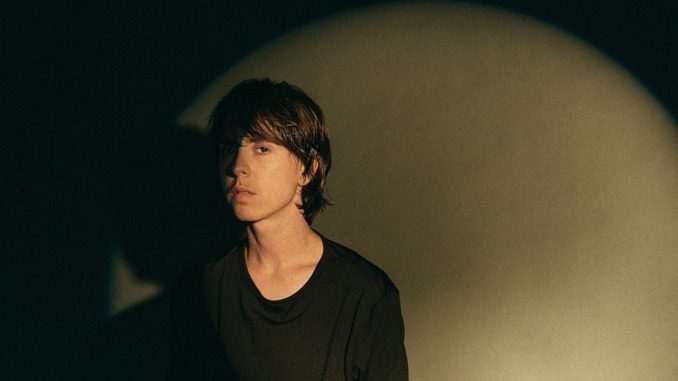If you watch the six-part Hulu docuseries McCartney 3, 2, 1 as a fan of The Beatles or Sir Paul McCartney in particular, it’s almost guaranteed you’ll find yourself thinking that music producer Rick Rubin might be the luckiest person on the planet.
Whether he’s sitting cross-legged on the floor soaking up McCartney’s remembrances of the past, or aggressively working the faders on a mixing desk dissecting the individual instruments on a Beatles classic together, we lay witness to Rubin experiencing the wish fulfillment of many a music lover, and gratefully he doesn’t waste the opportunity.
Under the auspices of this project, Rubin—one of the most influential and prolific record producers of the last four decades—engages Sir Paul in an intimately shot, one-on-one conversation and musical analysis of The Beatles’ discography. Edited down to six half hour, free-range, non-linear conversations, Rubin and McCartney just talk and noodle around like the still-excited and curious musicians they are, traversing well-worn stories from the origins of “Yesterday” to more revelatory moments like Macca sharing the artist’s performance that brought him to spontaneous tears.
At any given moment, their conversation could serve as an impromptu master-class in song construction, an affecting trip down memory lane for McCartney as he revisits musical gems from his past with startling clarity, or an unexpected contextual deconstruction of, arguably, music’s most influential pop band. And despite existing for just a decade (1960-1970), The Beatles’ music is still so ubiquitous that, as Rubin says in Episode 5, most have never thought about or really listened to the brilliant individual elements within their songs to understand why the band’s catalog remains so crucial and timeless.
And that is where McCartney 3, 2, 1 works best, when the songwriting genius is providing a firsthand, oftentimes mesmerizing primer for newcomers and experts alike about the complexities of what he, John Lennon, George Harrison, Ringo Starr, and producer George Martin hammered out in Abbey Road Studios with an almost journeyman-like attitude. Still nimble and energetic at 79-years old, McCartney remains a charming and accessible artist which means there’s real joy in spending time with him in this endeavor, too. Still making records (McCartney III released last December) also makes McCartney both a measured observer of his legacy and a delighted keeper of The Beatles’ creative flame.
What Rubin brings to the table is expertise and admiration. He’s a warm and informed interviewer, softly lobbing genuine curiosity in his questions to McCartney. And that sometimes strikes pure gold in terms of eliciting answers from Paul that have never been heard before, or unearthing an extra layer to a known story that deepens what we thought we knew about the musician or the band. And because the series is shot entirely in black and white (with multiple cameras capturing all angles of the conversation), when a new kernel of history is dredged up, or an authentic smile of delight is captured in McCartney’s reaction to a bass groove or a wonky warbled note, there’s potency in every revelation.
Where the series comes up a bit short is in its scope and topical presentation. The extremely loose format captures the immediacy of Rubin and McCartney’s organic conversation without the fussiness of what might typically be an overproduced documentary, but the later episodes suffer from topics folding back in on themselves, so there’s some repetition that is confusing in light of the short episode run times and what must have been an abundance of material left on the cutting room floor. A better edit would have tethered together related stories for more cohesive thematic discussions. And while there is a lot of charm in following along with an unfolding conversation like a fly on the wall, there’s also nothing wrong with providing audiences even a modest visual timeline so the band’s musical progression is better contextualized, like referencing The Beatles’ discography and where the songs featured in the series came from. The random sequencing of the music across all six episodes just doesn’t land how astounding the band’s ascendant musical maturity really was.
And for hardcore fans, like myself, the biggest disappointment with McCartney 3, 2, 1 is that it almost entirely focuses on McCartney’s work with The Beatles, with only a few digressions into his solo work with songs such as “Live and Let Die,” “Waterfalls,” and a bit on his first post-Beatles solo album, McCartney. To put it in perspective, Paul has been making music as a solo artist for five decades now, so to only get cursory representation of that incredible catalog feels like its cheating long-time fans, and newbies, out of the majority of his stellar career. Might there be future seasons to go into McCartney’s Wings and solo eras? One can only hope, but it’s not addressed within the series, or in the press notes. Assuming McCartney 3, 2, 1 is all we get, a better representation of all of Paul’s work in this series would have been more satisfying to those who aren’t just Beatle McCartney fans.
Having said that, even with the aforementioned quibbles, I spent the majority of McCartney 3, 2, 1 rapturously ingesting every story and anecdote served up across all six episodes with a huge smile on my face. Rubin and McCartney make every musical deep-dive on the piano or mixing desk session truly informative, sharing insights about minute details that breathe new life into songs sometimes taken for granted. Those moments, coupled with the archival band footage, personal photos and performance snippets of artists who deeply impacted McCartney’s own musical journey, gifted me with even more knowledge about Paul and The Beatles than I had at the start. And that’s no small feat considering how much I’ve consumed about the band and Macca over my lifetime. That McCartney 3, 2, 1 allows audiences to glean new insight from McCartney himself, while observing him rediscover the magic of the music he helped make is the definition of a worthy watch.
McCartney 3, 2, 1 premieres Friday, July 16th on Hulu.
Tara Bennett is a Los Angeles-based writer covering film, television and pop culture for publications such as SFX Magazine, Total Film, SYFY Wire and more. She’s also written books on Sons of Anarchy, Outlander, Fringe and the official history of Marvel Studios coming in 2021. You can follow her on Twitter @TaraDBennett.
For all the latest TV news, reviews, lists and features, follow @Paste_TV.




